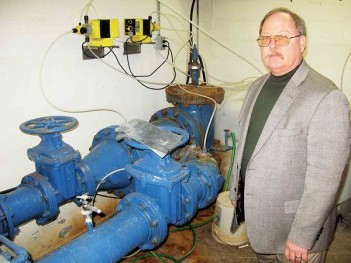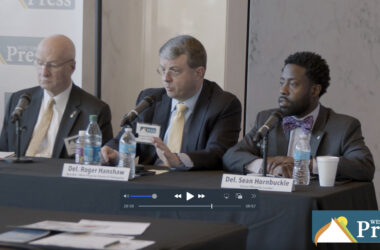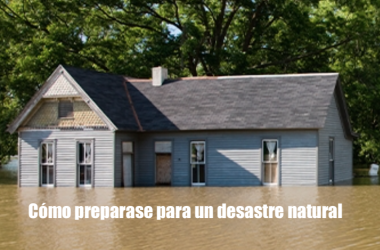
Vienna Mayor Randy Rapp poses for a photo in the treatment room for wells 13 and 14 near 58th Street.
VIENNA, W.Va. — The latest tests of the water in Vienna show C8 levels below the Environmental Protection Agency limits, city officials said at a press conference on Tuesday.
But any concentration is a health hazard, an attorney in the C8 lawsuit and a doctor involved in the C8 health study said.
From samples tested this month, the highest concentration was 0.116 parts per billion in one well, which is below the 0.4 ppb level cited by the Environmental Protection Agency as a health risk, Vienna Mayor Randy Rapp said. C8 was used by DuPont at the Washington Works to make Teflon, a non-stick coating with numerous applications including cookware.
Concentrations were 0.106 ppb at well 14, 0.116 at 13, 0.0505 at 12 and 0.115 at 11 in the 58th Street well field; 0.104 at 7 and 0.109 at 8 in the 32nd Street field; and 0.0727 at 9 and 10 at the Sam’s Club field, according to the results from the testing laboratory, ALS Group USA from Pennsylvania.
“That’s bad,” said Harry Deitzler, the attorney representing the clients in the C8 lawsuit against DuPont.
Deitzler cited the situation in New York where the state Department of Health ordered the town of Petersburgh to supply bottled water when levels of C8 were detected at less than 0.1 ppb and EPA Region 2 has indicated that residents of nearby Hoosick Falls, N.Y., should not drink water with levels at 0.1 ppb or more, according to media reports. In New Jersey, the Department of Health health advisory standard is 0.04 ppb.
C8 contamination was the basis of a class-action lawsuit against DuPont.
The settlement led to the C8 health study, which tracked the medical history of about 70,000 people in the region and found probable links between C8 exposure and kidney cancer, testicular cancer, ulcerative colitis, thyroid disease, pregnancy induced hypertension, including preeclampsia and hypercholesterolemia. Also, DuPont was required to pay for carbon filters to clean the water in systems, including Lubeck, Belpre, Little Hocking, Pomeroy and Tuppers Plains.
DuPont is the only source of C8, Deitzler said.
Filtration systems should be immediately installed as no level of C8 is safe, said Dr. Paul Brooks, whose company Brookmar conducted testing for the original C8 Health Project. For example, the science study shows C8 at levels of only 0.05 ppb in the body can lead to high cholesterol and affect the immune system, he said.
Even if exposure to C8 was zero, it could be years before it is no longer in the human body, depending on the concentration present, Brooks said. Moreover, the concentration of C8 is passed from mother to child, he said.
“That’s why this stuff has got to be gotten out of the water,” Brooks said.
The priority is the safety of the water supply, Rapp said Tuesday.
Carbon filters would cost the City of Vienna $6 million for each of its well fields because of how the water is collected, Rapp said.
Water is treated at the well fields then goes to the customer, Metz said. In Parkersburg, water goes from the well field to a central point at the treatment plant, he said.
The most recent testing in Parkersburg was done in September, with the levels ranging from 0.072 ppb to 0.013 ppb in three wells and non-quantifiable at two other wells. Testing of finished, or treated, water revealed a concentration of 0.031 ppb.
Vienna has stepped up the frequency of its tests as a matter of public safety and to determine a trend before other action is taken, which could include removing a well from service, Rapp said.
“We don’t have enough data,” he said.
Previous tests were done in May and December. The next test will be on March 14, Rapp said. Another change is each well is being individually tested rather than each well field as a combination, Metz said.
The EPA also is testing the water, he said. However, the city is having the water independently tested to ensure the accuracy of the results, Rapp said.
To read more from the Parkersburg News and Sentinel, subscribe here.





